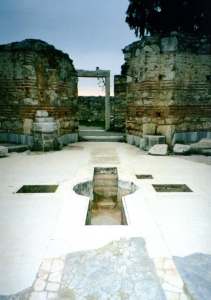| The
rite of initiation into the Christian church. |
 |
|
Byzantine
baptistry, shaped like a cross to symbolize cleansing by Christ's
death
|
The historical background
to this rite is probably in Jewish rites of
purification. These washings, however, were self-administered and repeated.
John the Baptist practiced a single baptism that he administered to others
for the sake of repentance and to prepare for the coming Day of the Lord.
Jesus was baptized by John. Early Christians made baptism a rite of entrance
into the church for all people. Formulas of baptism varied in the earliest
centuries. The New Testament gives evidence of baptism "in Christ," "in
the name of Jesus," and "in the name of the Father, and of the Son and
of the Holy Spirit." Formulas like these were always used with some form
of washing with water. The New Testament mentions baptism of families
but is silent on the baptism of infants. The norm in the earliest church
was the baptism of adults. Baptism was preceded by a period of catechization
and most often occurred at or in running water at the Easter observance.
Later other fixed times were added. Rites varied and Christians differed
about the relation of the bestowal of the Holy Spirit in relation to baptism.
Some held that the Holy Spirit was bestowed before baptism, others that
it was granted during baptism itself and still others taught that the
Holy Spirit was bestowed after baptism. The practice of the baptism of
infants appears to have grown slowly during the early centuries of the
church's existence.
|